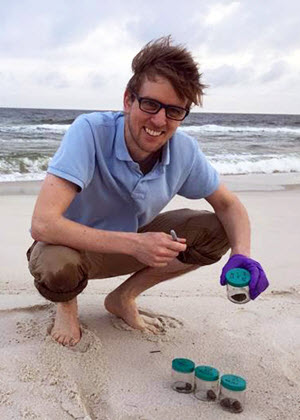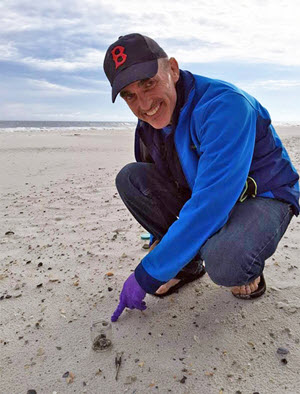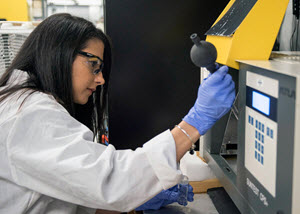
David Podgorski uses a Fourier Transform Ion Cyclotron Resonance Mass Spectrometer at the National High Magnetic Field Laboratory to analyze weathered oil samples and changes to their molecular structure. (Photo by Kristen Coyne)
Responders to the Deepwater Horizon spill used large quantities of dispersant to facilitate oil biodegradation, but could a different method be safer for the environment?
Oil compounds take on additional oxygen atoms as physical and chemical processes weather them. However, the classical methods that scientists use to analyze and describe these molecular compositional changes cannot detect the new oxidized products, limiting our understanding of their molecular structure, environmental fate, and potential toxicity.
The Gulf of Mexico Research Initiative awarded Dr. Ryan Rodgers a grant to investigate these products, the processes that yield them, and their potential toxicity using classical and new techniques. Rodgers and co-principle investigators Chris Reddy and Christoph Aeppli will use their findings to create a model that will help determine the rate, mass, and type of weathering products of future spills.

Christoph Aeppli labels oil samples collected from Alabama beaches. Chemical analysis of these samples will determine the degree of natural oil degradation that occurred since the Deepwater Horizon spill. (Photo by Christopher Reddy)
The team will use gas chromatography methods to analyze oil samples collected immediately after and in the years following the spill, identifying their chemical “fingerprints,” determining their origin, and characterizing changes to their molecular structure.
Fourier Transform Ion Cyclotron Resonance Mass Spectrometry (FTICRMS) – an analytical technique with significantly higher resolution than classical methods – will help researchers track molecular-level changes in the oxidized transformation products created during weathering.
The researchers will investigate how structure affects weathering by separating unweathered oil components into saturates (waxy oil compounds) and one to five+ ringed aromatics (hydrocarbons containing ring-shaped carbon structures) and then irradiating the compounds using simulated sunlight or incubating them in a dark mesocosm containing oil-degrading bacteria. The team will screen the resulting transformation products’ toxicity to determine the most and least harmful compounds.

Chris Reddy collects oil samples on Alabama beaches. These sand-oil aggregates continue to wash ashore six years after the Deepwater Horizon oil spill. (Photo by Christoph Aeppli)
The combined degradation and toxicity data will reveal whether the individual saturates and aromatic fractions release more or less toxic transformation products in response to biodegradation or photo-oxidation.
The researchers hope that responders to future spills can use this study’s model to examine oil compounds and inform remediation decisions based on degradation processes that yield less toxic transformation products.
Rodgers gave the example that, if biodegradation would release highly toxic compounds from a certain oil type, responders may decide to let surface oil be photo-oxidized or burned. Alternatively, if photo-oxidation would lead to toxic compounds, responders may choose to use dispersants to facilitate biodegradation.

Huan Chen tests the toxicity of photo-irradiated samples to identify which original crude oil components become more toxic with weathering. (Photo by Phoebe Z. Ray)
“We didn’t have the technology to do this kind of research ten or fifteen years ago,” said Rodgers. “Now, we can collect massive amounts of information about petroleum’s structural classes and how photo-oxidation and biodegradation make them more or less toxic. This information gives us as a community the best shot to understand how spilled petroleum will behave in the environment and will be immensely informative moving forward.”
The project’s researchers are Ryan Rodgers of Florida State University, Chris Reddy of Woods Hole Oceanographic Institution, andChristoph Aeppli of Bigelow Laboratory for Ocean Sciences. Their project is The State-of-the-Art Unraveling of the Biotic and Abiotic Chemical Evolution of Macondo Oil: 2010-2018.
************

Phoebe Ray works on a solar simulator at the National High Magnetic Field Laboratory, which will generate photo-oxidized oil samples for subsequent analysis. (Photo by Stephen Bilenky)
The Gulf of Mexico Research Initiative (GoMRI) is a 10-year independent research program established to study the effect, and the potential associated impact, of hydrocarbon releases on the environment and public health, as well as to develop improved spill mitigation, oil detection, characterization and remediation technologies. An independent and academic 20-member Research Board makes the funding and research direction decisions to ensure the intellectual quality, effectiveness and academic independence of the GoMRI research. All research data, findings and publications will be made publicly available. The program was established through a $500 million financial commitment from BP. For more information, visithttp://gulfresearchinitiative.org/.
